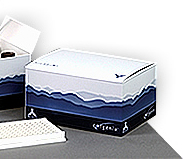
REAADS® Anti-Phosphatidylserine (aPS) IgG/IgM
$0.00
The REAADS® Anti-Phosphatidylserine (aPS) IgG/IgM test kit is a indirect, semi-quantitative ELISA used to detect antibodies against phosphatidylserine. Each assay uses a single or multi point calibrator to obtain IgG/IgM anti-phosphatidylserine antibodic concentrations from patient samples.
Downloads
Advantages
- Convenient ELISA Procedure
- For the specific determination of IgG/IgM isotypes
- Objective, accurate and reproducible
- Reagent complete kits
- Total incubation time: 40 minutes at room temperature
- Easily Automated
- Choice of single or multi-point calibration
Principle
The REAADS® IgG, IgM and IgA Anti-Phosphatidylserine (aPS) Test Kits are indirect, semi-quantitative ELISAs used to detect antibodies against phosphatidylserine. Each assay uses a single or multi point calibrator to obtain IgG, IgM or IgA anti-phosphatidylserine antibody concentrations from patient samples.
Procedure
Patient serum is diluted into sample diluent containing bovine serum (source of cofactor) and incubated in wells coated with phosphatidylserine. Any aPS antibodies present in the patient sample will bind to the coated wells. After removal of unbound serum by washing, antibodies specific for human IgG, IgM or IgA labeled with horseradish peroxidase (HRP), are added to form complexes with the phosphatidylserine bound antibodies.
The wells are washed, and a chromogenic substrate is added, resulting in a color change that is proportional to the amount of antibody present. The assay is stopped by the addition of a stopping solution. Results are obtained by reading the O.D. (optical density) of each well at 450nm in a spectrophotometer. The O.D. values of control and patient samples are multiplied by the calibrator conversion factor to obtain IgG, IgM or IgA anti-phosphatidylserine antibody concentrations in GPS, MPS or APS units, respectively. Assay cutoffs have been established at 16 GPS, 22 MPS and 20 APS units.
Clinical Performance
Clinical Specificity
Serum samples from multiple healthy blood donor populations were assayed for the presence of antiphosphatidylserine antibodies. Specificity was shown to be 96% for both IgG and IgM antibodies, and 95% for IgA.
Clinical Sensitivity
Unselected SLE samples were tested to determine the clinical sensitivity of the aPS assay. The resulting sensitivity was 22.2% for IgG, 25% for IgM and 11.1% for IgA. The clinical sensitivity of the assay for Antiphospholipid Syndrome (APS) was determined by comparing aPS test results from two groups of selected patients:
| Group 1 – Primary APS | IgG aPS | IgM aPS | IgA aPS |
|---|---|---|---|
| Assay cutoff | 16 GPS | 22 MPS | 20 APS |
| Average value | 61.6 GPS | 33.4 MPS | 21.1 APS |
| % positive | 90.9% | 54.5% | 36.4% |
| Group 2 – SLE control | IgG aPS | IgM aPS | IgA aPS |
| Assay cutoff | 16 GPS | 22 MPS | 20 APS |
| Average value | 9.2 GPS | 9.9 MPS | 11.2 APS |
| % positive | 11.1% | 11.1% | 0% |
- Group 1 – patients with Primary APS
- Group 2 – SLE patients with no history of thrombosis or thrombocytopenia (controls). The results are shown in the chart above.
The prevalence and mean levels of aPS antibodies were higher in Primary APS patients than in the SLE control group. These assays, when run in concert with additional anti-phospholipid and lupus anticoagulant assays, provides a more complete profile for establishing a diagnosis of Antiphospholipid Syndrome and for assessing the risk of thrombotic complications in SLE patients.
Background
Elevated serum levels of anti-phospholipid antibodies are associated with an increased risk for recurrent arterial and venous thrombotic events, thrombocytopenia and fetal loss. These are the main clinical manifestations of Antiphospholipid
Syndrome. Phosphatidylserine is found in the membranes of platelets and endothelial cells, which participate in the coagulation cascade. Due to its physiologic role, testing for autoantibodies directed towards phosphatidylserine provides not only more relevant results, but also additional information to assess the risk of thrombosis.